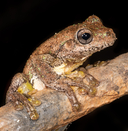|
Distribution and Habitat
Country distribution from AmphibiaWeb's database: Australia
South-eastern and south-western Queensland, throughout all of New South Wales and into
northern Victoria and south-eastern South Australia. The extent of occurrence of the species is approximately 635400 km2.
Life History, Abundance, Activity, and Special Behaviors
Varied habitats. Wet and dry forest, woodlands, shrublands and open areas. Along the coast
often in trees and shrubs among streamside vegetation. In inland regions often in low lying
areas adjacent to creeks, rivers and lagoons. Often found a long distance from water.
Males call from the ground or in vegetation near water in spring and summer. Eggs are laid in
still water.
Trends and Threats
No known declines and large extent of occurrence.
Threats: Development in south-eastern Queensland and central New South Wales. Land conversion for farming. Also climate change (see news of the week in Comments).
Conservation Measures: None in place.
Comments
This species was featured in news of the week on August 29, 2022:
Cities, suburban gardens, and other human modified areas are drastically different from frogs’ natural habitats. They are often warmer, noisier, artificially brighter, and more polluted. Gathering the data needed to understand whether frogs are adapting their behaviours to cope with these conditions is challenging, but increasingly, citizen science data is allowing us to investigate large-scale ecological questions like this. Liu et al. (2022) analysed over 226,000 frog records from across Australia to examine whether human-driven habitat modification influences the breeding phenology or call characteristics of frogs. They found that frog breeding seasons began earlier and were almost 3 weeks longer in areas that were highly modified by humans. However, habitat modification did not affect frog call characteristics. Their results suggest that human-induced phenological changes could be widespread among frogs, with largely unknown ecological consequences. This research also highlight the incredible value of citizen science data in better understanding amphibians in a changing world. (Written by Gracie Liu)
References
Barker, J., Grigg, G. C., and Tyler, M. J. (1995). A Field Guide to Australian Frogs. Surrey Beatty and Sons, New South Wales.
Cogger, H.G. (1992). Reptiles and Amphibians of Australia. Reed Books, New South Wales.
Hero, J.-M., Littlejohn, M., and Marantelli, G. (1991). Frogwatch Field Guide to Victorian Frogs. Department of Conservation and Environment, Victoria.
Originally submitted by: Jean-Marc Hero et. al. (first posted 2002-04-05)
Edited by: Ambika Sopory, Michelle S. Koo (2022-08-28)Species Account Citation: AmphibiaWeb 2022 Litoria peronii: Peron's Tree Frog <https://amphibiaweb.org/species/1292> University of California, Berkeley, CA, USA. Accessed Jun 4, 2025.
Feedback or comments about this page.
Citation: AmphibiaWeb. 2025. <https://amphibiaweb.org> University of California, Berkeley, CA, USA. Accessed 4 Jun 2025.
AmphibiaWeb's policy on data use.
|





 Map of Life
Map of Life